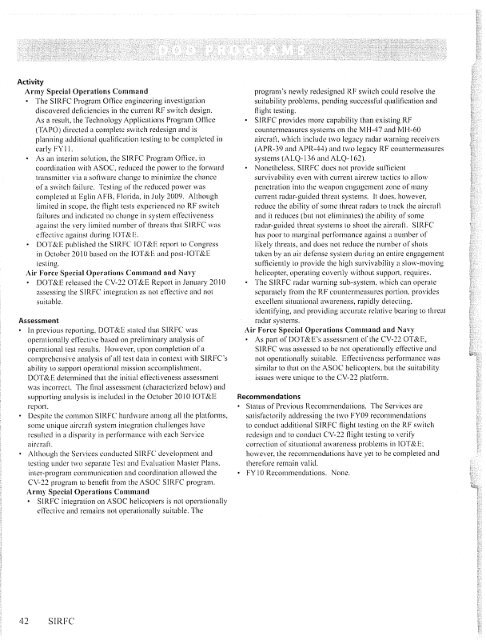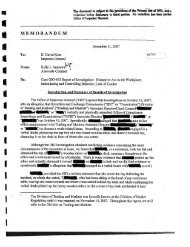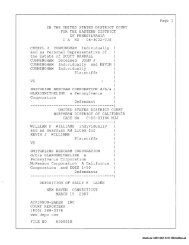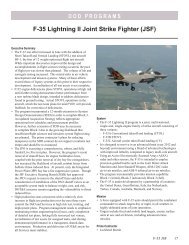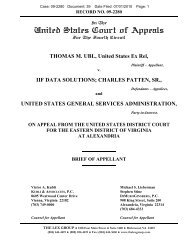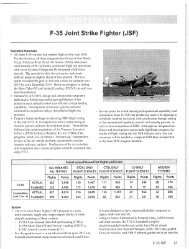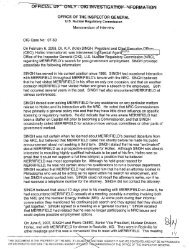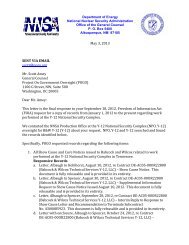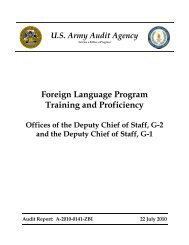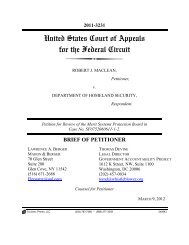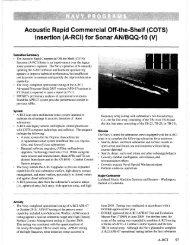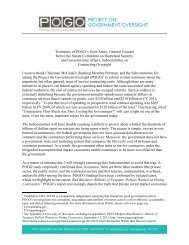F-35 Joint Strike Fighter (JSF)
F-35 Joint Strike Fighter (JSF)
F-35 Joint Strike Fighter (JSF)
Create successful ePaper yourself
Turn your PDF publications into a flip-book with our unique Google optimized e-Paper software.
Activity<br />
Army Special Operations Command<br />
▪ The SIRFC Program Office engineering investigation<br />
discovered deficiencies in the current RF switch design.<br />
Asa result, the Technology Applications Program Office<br />
(TAP()) directed a complete switch redesign and is<br />
planning additional qualification testing to be completed in<br />
early FY11.<br />
• As an interim solution, the SIRFC Program Office. in<br />
coordination with ASOC, reduced the power to the forward<br />
transmitter via a software change to minimize the chance<br />
of a switch failure- Testing of the reduced power was<br />
completed at Eglin AFB, Florida, in July 2009. Although<br />
limited in scope. the flight tests experienced no RF switch<br />
failures and indicated no change in system effectiveness<br />
against the very limited number of threats that SIRFC was<br />
effective against during IOT& E.<br />
• DOT&E published the SIRFC IOT&E report to Congress<br />
in October 2010 based on the IOT&E and post-IOT&E<br />
testing.<br />
Air Force Special Operations Command and Navy<br />
• DOT&E released the CV-22 OT&E Report in January 2010<br />
assessing the SIRFC' integration as not effective and not<br />
suitable.<br />
Assessment<br />
• In previous reporting. DOT&E stated that SIRFC was<br />
operationally effective based on preliminary analysis p<br />
operational test results. However, upon completion of a<br />
comprehensive analysis or all test data in context with SIRFC's<br />
ability to support operational missGon accomplishment.<br />
DOT&E determined that the initial effectiveness assessment<br />
was incorrect. The final assessment (Characterized below) and<br />
supporting analysis is included in the October 2010 IOT&E<br />
report.<br />
• Despite the common SIRFC hardware among all the platforms,<br />
some unique aircraft system integration challenges have<br />
resulted in a disparity in performance with each Service<br />
aircraft.<br />
• Although the Services conducted SIRFC development and<br />
testing under two separate Test and Evaluation Master Plans,<br />
inter-program communication and coordination allowed the<br />
CV-22 program to benefit from the ASOC SIRFC program-<br />
Army Special Operations Command<br />
• SIRFC integration on ASOC helicopters is not operationally<br />
effective and remains not operationally suitable- The<br />
42 SIRFC<br />
program's newly redesigned RF switch could resolve the<br />
suitability problems. pending successful qualification and<br />
flight testing-<br />
• SIRFC provides more capability than existing RF<br />
countermeasures systems on the M11-47 and M1-1-60<br />
aircraft. which include two legacy radar warning receivers<br />
(APR-39 and APR-44) and two legacy RF countermeasures<br />
systems (A LQ-136 and A LQ-J62).<br />
• Nonetheless. SIRFC' does not provide sufficient<br />
survivability even with current aircrew tactics to allow<br />
penetration into the weapon engagement zone of many<br />
current radar-guided threat systems. .1 I does- d however,<br />
reduce the ability of some threat radars to track the aircraft<br />
and it reduces (but not eliminates) the ability of some<br />
radar-guided threat systems to shoot the aircraft. SIRFC<br />
has poor to marginal performance against a number of<br />
likely threats, and does not reduce the number of shots<br />
taken by an air defense system during an entire engagement<br />
sufficiently to provide the high survivability a sfow-moving<br />
helicopter, operating covertly without support, requires.<br />
• The SIRFC radar warning sub-system. which can operate<br />
separately from the RF countermeasures portion, provides<br />
excellent situational awareness. rapidly detecting.<br />
identifying. and providing accurate relative bearing to threat<br />
radar systems.<br />
Air Force Speeial Operations Command and Navy<br />
• As part of DOT&E's assessment of the CV-22 OT&E,<br />
SIRFC was assessed to be not operationally effective and<br />
not operationally suitable- Effectiveness performance was<br />
similar to that on the ASOC helicopters. but the suitability<br />
issues were un ique to the CV-22 platform.<br />
Recommendations<br />
• Status of Previous Recommendations. The Services are<br />
satisfactorily addressing the two FY09 recommendations<br />
to conduct additional SIRFC flight testing on the RF switch<br />
redesign and to conduct CV-22 flight testing to verify<br />
correction of situational awareness problems in IOT&E;<br />
however, the recommendations have yet to be completed and<br />
therefore remain valid.<br />
• FY 1(1 Recommendations. None.


